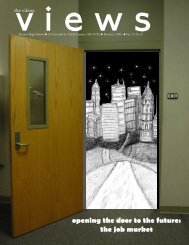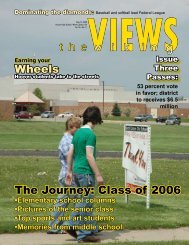Issue 6 - North Canton City Schools - sparcc
Issue 6 - North Canton City Schools - sparcc
Issue 6 - North Canton City Schools - sparcc
You also want an ePaper? Increase the reach of your titles
YUMPU automatically turns print PDFs into web optimized ePapers that Google loves.
23<br />
Social Media<br />
Ali McNeese<br />
Staff Writer<br />
While social networking is foreign<br />
to older generations, it is<br />
second nature to most students<br />
at Hoover High School. Technology has<br />
dramatically changed the way teenagers<br />
communicate all over the globe. Instead<br />
of the traditional letter writing or face-toface<br />
interaction, teens communicate much<br />
easier and more efficiently through social<br />
networking websites such as: Twitter,<br />
Facebook, Skype, Tumblr, Instagram and<br />
the list goes on.<br />
Science teacher Mr. Steve Wood had<br />
a Facebook fan page for his students last<br />
year in order to advertise information<br />
and send helpful links. In order to have<br />
access to it, students with a Facebook<br />
page would have to ‘like’ the fan page.<br />
The students could then post on the wall<br />
and see the links that Wood and other<br />
students had posted.<br />
“It’s an easier way to<br />
spread information,” he said. “Students<br />
don’t check their G-mails as much as<br />
they do Facebook or Twitter.”<br />
Wood has discontinued the use of his<br />
Facebook fan page this year because he<br />
noticed a large decrease in the number<br />
of students that still use their Facebook<br />
accounts.<br />
“I think most teens are migrating away<br />
from it because all the old people are on<br />
it now,” he said. “If I were to do it again,<br />
I’d probably go for Twitter.”<br />
Junior Thomas Showen who has<br />
accounts on Facebook and Twitter, uses<br />
the social networks because of their<br />
efficiency.<br />
“It’s easier to communicate with<br />
people because you don’t even have to be<br />
near them to talk to them,” he said.<br />
Sophomore Madison DeChellis<br />
agreed. She also uses Twitter to<br />
communicate with friends and see what’s<br />
going on.<br />
“If you need to know what time<br />
something is going on at, you can tweet<br />
it and people will respond,” she said.<br />
While Showen and DeChellis<br />
both said they benefit from the<br />
world of social media, senior Logan<br />
Sisca said he believes the media often<br />
times gives people the wrong idea about<br />
social networking.<br />
“As with most stories on the news,<br />
incidents involving social media are<br />
often negative,” Sisca said. “With so<br />
much attention drawn to cyber bullying,<br />
it is difficult to see the beneficial aspects<br />
of social networking through this<br />
“It’s an easier<br />
way to spread information.”<br />
-Mr. Steve Wood<br />
negativity.”<br />
DeChellis said she believes the older<br />
generations look down on the social<br />
media we use today because the bad<br />
aspects of it are the only things that are<br />
highlighted.<br />
“They look down on it and think,<br />
‘how can those kids be saying the things<br />
that they’re saying,’” Dechellis said. “In<br />
older generations, people would say it to<br />
each other’s faces.<br />
According to a 2009 article in “The<br />
Washington Times,” research was<br />
conducted at the University of Southern<br />
California and the University of<br />
California at Berkeley to study the online<br />
habits of 800 teenagers. Leader of the<br />
study, Mizuko Ito, validated the benefits<br />
of social networking.<br />
“There are myths about kids spending<br />
time online — that it is dangerous or<br />
making them lazy,” Ito said. “We found<br />
that spending time online is essential for<br />
young people to pick up the social and<br />
technical skills they need to be competent<br />
citizens in the digital age.”<br />
In spite of the typical misconceptions,<br />
Wood said he did not have any<br />
prior thoughts on the negatives of social<br />
media before he created his Facebook fan<br />
page.<br />
“I didn’t go into it thinking it was<br />
evil,” Wood said. “I think it’s amoral —<br />
it just depends on how you use it.”<br />
Although social media is not only<br />
used to socialize and ‘creep’ on others,<br />
people also try to find connections<br />
with others who have similar ideas<br />
or thoughts. According to “The<br />
Washington Times” social networking<br />
“expands one’s circle of friends, boosts<br />
self-directed learning and fosters<br />
independence.”<br />
“While the majority of teens use<br />
sites such as such as Facebook to ‘hang<br />
out’ with people they already know in<br />
real life, a smaller portion uses them to<br />
find like-minded people,” stated a source<br />
in the article.<br />
Learning to communicate through<br />
social media will not just be about<br />
consuming media, but also producing it<br />
in the near future.<br />
“Learning to communicate like this is<br />
contributing to the general circulation of<br />
culture,” said a source in the article.<br />
Though parents are concerned their<br />
teenagers have their devices attached to<br />
their hip, it’s no surprise social media is<br />
becoming a more important part of our<br />
culture.<br />
“[Parents] need to accept that<br />
technology is a necessary and important<br />
part of the culture for young people,” a<br />
source stated from the article in “The<br />
Washington Times." •<br />
The Viking Views.indepth

















